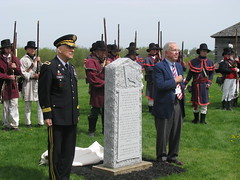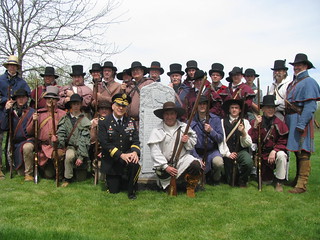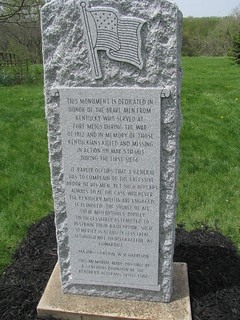Courtesy the Toledo, Ohio Blade
Story by Tom Henry, Blade staff writer
[caption id="" align="aligncenter" width="576"]

Re-enactors fire cannons to mark the First Siege of Fort Meigs that occurred on May 1, 1813. The celebration that concludes today is anchored at Fort Meigs but activities go on across the river. THE BLADE/LORI KING
Kentucky was a major player in the War of 1812, also known as the Second War for American Independence. Reenactments and ceremonies are taking place across the nation in remembrance through January 2015 of those who gave their lives.
FORT MEIGS, Ohio -- Beyond the sounds of musket volleys and cannon blasts, the smells of campfires and gunpowder, the sights of blacksmiths, tents, 19th century soldiers, and drum-and-fife corps, one might reasonably wonder what has drawn throngs of people to Fort Meigs this weekend for a three-day bicentennial celebration of its first siege.
Click here for the original story!
Click here for additional photos!
There’s an obvious love of history. But there’s something more than that.
Brig. Gen. Patrick Dolan, the only chaplain in the Army National Guard who’s a general and one of only 11 chaplain-generals in the entire U.S. military, said such events draw people with an innate curiosity of what it means to bond together as a nation.
“We’re all in this together. It’s about a sense of self-sacrifice instead of entitlement,” Dolan said during an interview moments after helping to dedicate a Kentucky Soldiers Memorial at Fort Meigs. The memorial honors Kentucky soldiers who came north in rugged conditions — at great risk to themselves, with no guarantees — to help Ohio soldiers fight the British and Native Americans in the War of 1812.
[caption id="" align="alignleft" width="240"]

Chaplain (Brig. Gen.) Pat Dolan was on hand to represent the National Guard during the War of 1812 bicentennial reenactment at Fort Meigs, Ohio.
“The whole reason we came here was neighbor helping neighbor,” said Dolan, a member of the Kentucky National Guard and a veteran of Operation Iraqi Freedom.
That feeling of self-sacrifice and neighbor-helping-neighbor also resonates with Larry Nelson, a Bowling Green State University adjunct assistant history professor who has written several books about the Ohio frontier. Mr. Nelson spent 24 years as Fort Meigs State Memorial site manager until his retirement from the Ohio Historical Society in 2004.
“I hope they get a sense of heroism,” Mr. Nelson said after giving a presentation about the War of 1812, during which he said that Americans, Canadians, and British remain divided over why it started, what was accomplished, and who won.
“It’s a war that tells us about ourselves, good bad or indifferent. It’s a war when America was at its best and worst. It’s a war that needs to be remembered,” Mr. Nelson said.
Many people who spoke at Fort Meigs in Perrysburg and at an affiliated event Saturday afternoon at Fort Miamis in Maumee drew parallels and distinctions between the War of 1812 and more recent wars, such as those in Afghanistan and Iraq.
A common denominator has been sacrifice, they said.
“We know that in the natural world all things are connected, and so it is in history. The rich history of Ohio is both amazing and engaging and should not be forgotten,” Steve Madewell, Metroparks of the Toledo Area director said as he opened the Fort Miamis event, in which a marker was dedicated to honor a British regiment.
[caption id="" align="alignright" width="320"]

Chaplain (Brig. Gen.) Pat Dolan with some new friends during the War of 1812 bicentennial reenactment at Fort Meigs, Ohio.
The bicentennial celebration, which concludes today, is anchored at Fort Meigs but has included activities on both sides of the Maumee River.
Rick Finch, Fort Meigs site manager, said three years of planning went into the events.
Canadian re-enactor troops fire muskets in a ceremony to commemorate Fort Miamis. Canada was well on its way to nationhood during the War of 1812.
On Friday, 300 schoolchildren and 120 re-enactors interacted during the daytime, followed by a night artillery barrage observed by some 600 spectators.
About 2,000 people attended Saturday’s events at the fort, with a similar number expected today.
Activities begin at 10:30 a.m. and continue through 5 p.m., with the battle demonstration scheduled for 2 p.m.
Admission is $9 for adults, $8 for seniors, and $5 for students. Children 5 and under are free.
Some 625 re-enactors are participating this weekend, held in commemoration of the bloodiest battle at the fort. That’s nearly four times as many re-enactors as many other events there, Mr. Finch said.
[caption id="" align="alignleft" width="240"]

A monument recognizing the Kentucky soldiers who came north in rugged conditions — at great risk to themselves, with no guarantees — to help Ohio soldiers fight the British and Native Americans in the War of 1812.
“It’s been wonderful to have the fort come back to life,” he said. “I hope people get a real appreciation for the sacrifices and hardships. Even though the technology has changed, there is some consistency about the soldiering life.”
Rob Whitman, National Park Service ranger at Perry’s Victory and International Peace Memorial on South Bass Island, described how the Battle of Lake Erie was a turning point in the War of 1812, often viewed as a forgotten war.
Navy Comm. Oliver Hazard Perry’s victory was the first and only time the British lost an entire navy squadron in battle.
The construction of that landmark, a 352-foot peace memorial on South Bass Island, symbolized the desire for a new start. Mr. Whitman and others noted the United States has never been at war with the British or with Canada since.
At the Fort Miamis ceremony, Roy Norton, Consul General of Canada, said Canada wasn’t recognized as a country until 1867 — more than 50 years after the War of 1812 ended in 1815 — but was well on its way to nationhood then.
He said the United States and Canada now reap benefits of sharing the world’s largest nonmilitarized border, including trade. Ohio exports more to Canada than its next 11 export destinations combined, he said.
“Our citizens live with complete confidence they will never be attacked by the United States,” Mr. Norton said. “As allies, best friends, and economic partners, we work together daily.”
Contact Tom Henry at: thenry@theblade.com or 419-724-6079.